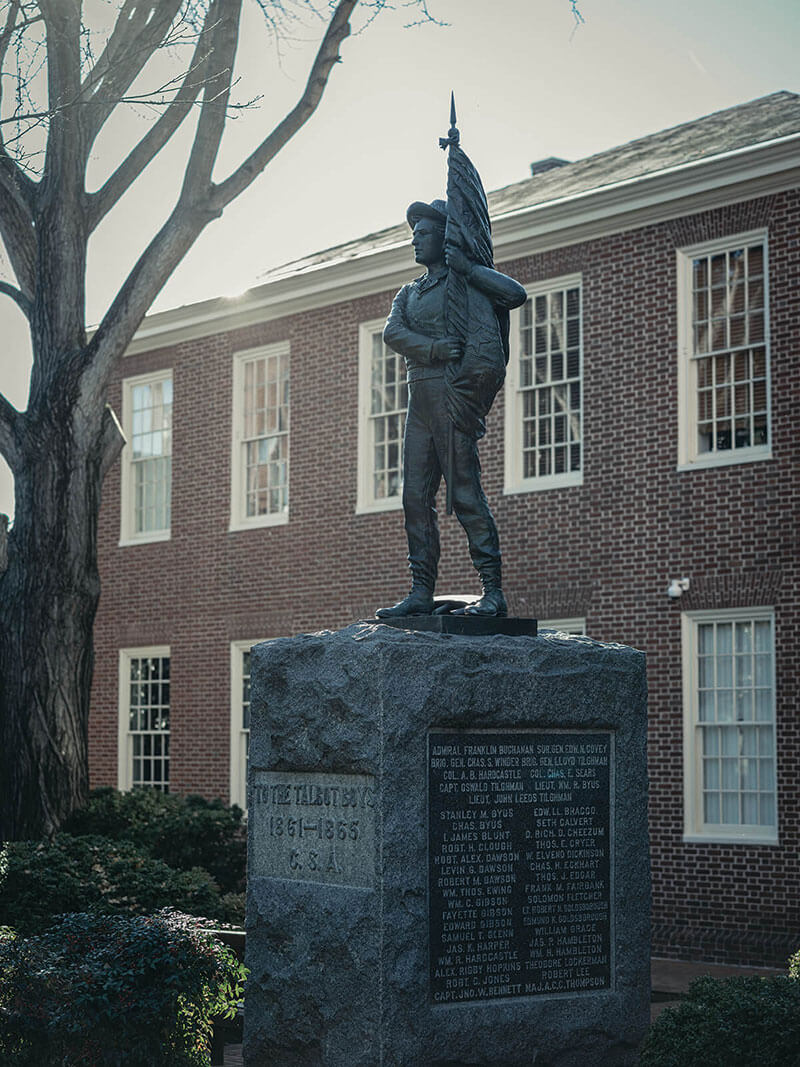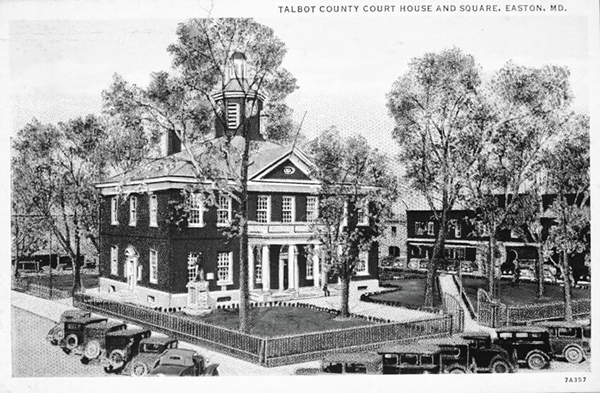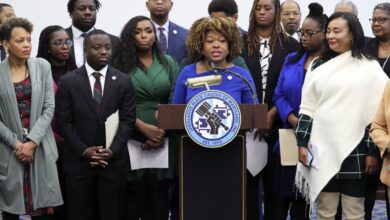After Decades of Silence, the Eastern Shore Begins to Reckon With its Difficult History


AN ORDINARY WEEKEND in downtown
Easton, the brick sidewalks are mostly empty,
save for the occasional local out for a stroll or a
handful of tourists taking in the iconic Colonial
architecture of Maryland’s Eastern Shore. With
only 16,000 residents, it’s the second-biggest town
on the peninsula, a quaint yet popular stopover
for folks from Baltimore and Washington, D.C., on
their way to Ocean City.
But on a Saturday afternoon this past August,
a commotion could easily be heard from several
blocks away as some hundred people gathered at
the Talbot County Courthouse. Wearing masks and
holding signs, their voices carried as they answered
a call of “Whose courthouse?” with a unified “Our
courthouse!” from a grassy lawn in front of the
looming government building, built in 1794.
Four days earlier, the Talbot County Council had
convened inside the South Wing, sitting along a
dark wooden bench separated by plexiglass dividers
beneath the official seal of “Tempus Praeteritum Et
Futurum,” or “Times, Past and Future,” as they voted
on an issue that had grown increasingly urgent
as months wore on. Earlier in the summer, after a
thousand protestors rallied outside on Washington
Street following the police killing of George Floyd,
calls for Black Lives Matter quickly dovetailed with a
demand to remove the “Talbot Boys.”

The Talbot Boys statue in December 2020.
In front of the courthouse’s grand entrance, the
bronze statue, erected in 1916, depicts a young Confederate
soldier carrying a Confederate battle flag
atop a granite base that bears the names of 96 local
Confederate soldiers and the inscription “1861-1865 C.S.A.,” or Confederate
States of America.
“George Floyd’s death tugged at the conscience of this country,
and people began to connect it to Confederate monuments and
the messages that they send,” says Richard Potter, an Easton native
and head of the local NAACP, who as a boy was mesmerized
by the childlike soldier, sensing he must have done something
special to receive such a significant perch. Only years later would
he become rattled by its history. “The courthouse is meant to be a
place where we can go and get a fair and just trial. And yet to get
inside, Black people have to walk past a monument that says you
belong in bondage.”
This was not the first time that Easton residents had called for
the statue’s removal. In 2015, Potter made the request after a white
supremacist murdered nine people at the Emanuel African Methodist
Episcopal Church in Charleston, South Carolina. Following a closed-door
vote that violated Maryland’s open meetings law, the council
unanimously chose to keep the statue where it stood. Calls came
again after a white nationalist rally in Charlottesville, Virginia, left
one protestor dead in 2017, then again in 2020, when some 700 letters,
including one from this writer, flooded the inboxes of the county
councilmembers, as similar monuments came down all across the
United States.
Protest at the Talbot County Courthouse, Easton, 8/15/2020
It was these events, and further conversations with community
members, that inspired Council President Corey Pack to propose the
removal of the Talbot Boys last summer, even after voting to keep it
in 2015, at the time reasoning that it was history. “A man who fails to
change his mind will never change the world that’s around him,” said Pack, the council’s first and only Black member, as the conversation
grew contentious leading up to the vote that August evening.
Other council members—Chuck Callahan, Frank Divilio, and
Laura Price—expressed opposition to the resolution, pointing to
the COVID-19 pandemic, limited public input, and even the inability
of the deceased Confederate honorees to be present. Price, in a
previous meeting, also resisted the adoption of a diversity statement.
“We have a lot of other problems here—I don’t think that
this is one of them,” she said, referring to county government, but
for many, speaking directly to the larger failure of the town, state,
and country to reckon with its racial past and present.
In the end, the council voted 3-2 to keep the Talbot Boys—believed to be the last Confederate monument, outside battlefields
and cemeteries, on public property in Maryland.
“The removal of this monument would not change the history
of this county,” said councilmember Pete Lesher that
evening. The local historian co-sponsored the resolution
for removal, despite being a descendent of
men listed on the statue’s base. “But the number
who have expressed their feelings on this matter
have made it clear that this is indeed a powerful
symbol, and our actions on it tonight, I’m afraid,
sadly speak of who we are now as a county, and the
extent to which we have not yet changed.”
Within a matter of minutes, a protest emerged
outside of the council’s windows, with demonstrators
chanting, “Take it down,” “Vote them out,” and “Black
Lives Matter,” causing the meeting to end early.

























































